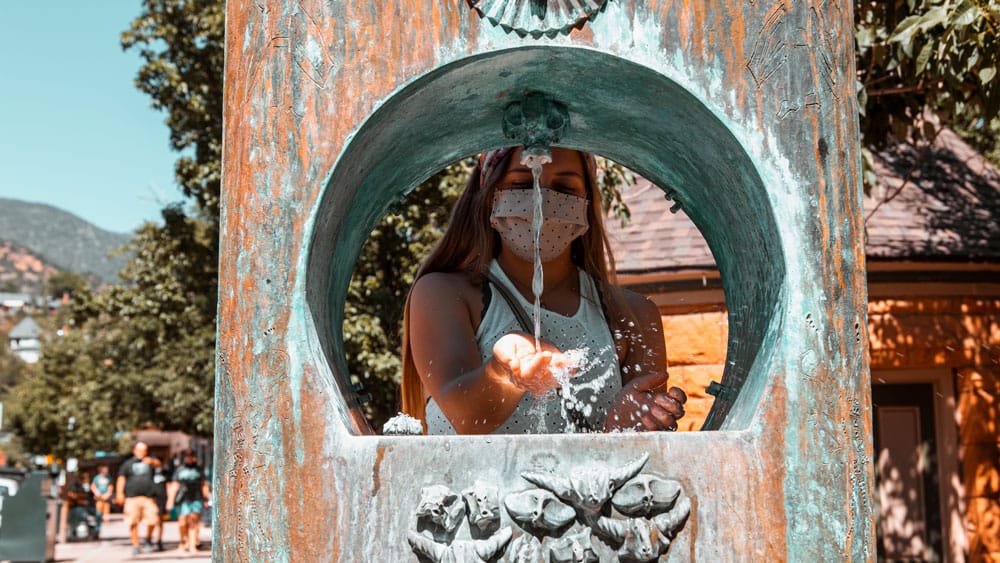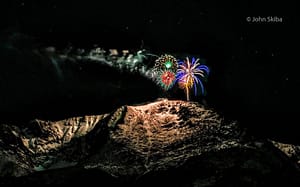Manitou Springs Mineral Springs Tour
Long before it was known for coffin races, fruitcake festivals and the intimidating Incline, Manitou Springs was known as a place for wellness — including playing home to the multiple mineral springs for which it is named. Today, those springs still play a role in the magic of Manitou, connecting geology, history and the present day for all who pass by.
Follow along as we take a tour of these famous springs, detailing where to find them, what mineral properties you can expect and the general “flavor” you can expect from each one. When you’re done, download a handy map from the Manitou Springs Chamber and take a real-life tour complete with samples. Make it a family scavenger hunt, a creative date night or a new way to explore Manitou Springs. We’ve even included a recipe for “Manitou Lemonade” at the bottom in case you want to live like a local.
Anatomy of a Mineral Spring
Before we set off on our tour, let’s take a crash course in the geology that powers the mineral springs of Manitou. Manitou Springs water comes from the surrounding foothills. On its journey to the town, it passes through natural aquifers below the ground. These aquifers, also called karst aquifers, formed as running water dissolved limestone and minerals, creating sinkholes, spaces, gaps and caverns. Up the Road, Cave of the Winds was formed in a similar fashion.
Back in the present day, water still runs through these spaces and the dissolving limestone mixes in, creating that bubbling soda water affect that surprises new visitors year over year. The water picks up even more minerals as it is pulled upward to the springs. Every spring is located in a different spot, which changes the minerals that enter the spring, the level of effervescence and the taste.
Now that you know the why and the how of the Manitou Mineral Springs, let’s get to know each of the town’s 8 springs a little better.
Seven Minute Spring by Manitou Springs Heritage Center
We’ll kick off this tour on the edge of Manitou Springs at the site of Seven Minute Spring. Located across from the Manitou Springs Heritage Center, which has an excellent exhibit on the bottling plants of early Manitou, Seven Minute Spring is tucked into a gorgeous gazebo. Drilled more than 100 years ago to fancy up the nearby Mansions Hotel, the carbonation in the spring would cause it to erupt, you guessed it, every seven minutes. According to the Mineral Springs Foundation, it has the lowest content of minerals in comparison to the other springs, with the exception of zinc. Most visitors report it is the milder of the springs, probably due to the low mineral content.
Shoshone Spring Near Navajo Avenue
You can get to the next spring by walking into Manitou Springs along the same side of Manitou Ave. It is about half a mile from Seven Minute, so feel free to hop in the car and park over in the Hiawatha Gardens lot or at a meter (pay your meter). Shoshone is located just past St. Andrews, but before the next strip of retail shops. It has more than twice the mineral content of Seven Minute Spring, and the most lithium of all of the city’s springs. It also has the most calcium and no iron. Taste wise, it’s a lot stronger than Seven Minute, so be prepared for a … sulphureous experience.
Navajo Spring by the Manitou Springs Penny Arcade
You won’t have to walk far to get a sample of Navajo Spring, the next stop in our tour. Navajo is located by the Penny Arcade and the iconic Patsy’s Candy about 300 feet away from Shoshone, as the Google flies. Despite practically being a next-door neighbor to Shoshone, Navajo has a much milder mineral profile (and flavor). It does have the most alkalinity and it was a source of water for the bottling plants discussed at the Manitou Springs Heritage Center. Navajo is known for being very mild. Many comment that it is “sweet.” Try for yourself to decide if that’s accurate.
Cheyenne Spring
There’s really no directional advice for navigating to Cheyenne Spring. It’s plumb in the middle of the sidewalk as you head further into town along Manitou Avenue. It’s one of the more popular springs due to its location. Another “sweet” spring, Cheyenne is old — like, really old. The structure that houses the water is a young 130ish years old in comparison to the thousands of years the stream has run below present-day Manitou Springs. Unlike Shoshone Spring, Cheyenne and Navajo carry remarkably similar mineral profiles. However, they both lack iron, just like Shoshone.
Wheeler Spring Near the Cliff House
For the next stop on the mineral springs tour, you’ll want to duck over to Park Avenue Just off of Canon Avenue behind the arcade and the Manitou Bathhouse. Wheeler has high copper and magnesium content and just a touch of iron. That metallic taste does come through in the water. It’s also one of the neatest and oldest spring structures in the city, built by the same Wheelers who built the Town Clock that welcomes Santa for a visit each year. The walk over to the spring is worth your time. The Cliff House is beautiful, and you can check out Manitou’s old creek infrastructure and older buildings and homes.
Stratton Spring Near the Roundabout and The Loop
Our journey takes us from the sight of the Cliff House back into downtown Manitou. Specifically, the roundabout near the locally owned Loop Restaurant just before Soda Springs Park. We’ll also get to hang out on the other side of the street for just a brief moment before the next destination. The mineral profile of this spring is tame. Not too much of any one mineral and no traces of iron. While it is not considered a sweet fountain, it is mild and refreshing, like drinking a club soda with the slightest hint of minerals. The sculpture that houses the spring is a beautiful work of art, well worth a photo or two.
Twin Spring on Ruxton Avenue
If you search for Twin Spring online, you’re likely to feel a bit confused. Many maps place it near Manitou Brewery. However, you can find it by turning left at the roundabout and heading up Ruxton Avenue. The spring will be on the left side of the street. This is the stream of Manitou Lemonade fame, the one the locals point to whenever someone asks the best spring for the recipe (see below). Twin Spring lacks copper, iron and manganese, so that might be an explanation for its milder flavor. Most of its mineral content aligns more with the low counts found in Seven Minute that any of its sister springs in the area. Bring a one-gallon water bottle to carry home your prize. You can even wait until you’re done at the final stop to double back so you won’t have to carry it all over town.
Iron Spring/Iron Geyser by Miramont Castle and Iron Springs Chateau
Located along Ruxton Avenue just past Miramont Castle but before the Iron Springs Chateau and the Cog Railway station, Iron Geyser is another heavy hitter in the mineral department. It has the most fluoride, iron, potassium, silica, sodium and sulfate and the least amount of zinc and magnesium. The higher content is likely due to its position in the waterway. Despite its name, Iron Geyser won’t be mimicking Old Faithful anytime soon. Its tap points downward into the bowl. While you’re sipping, note the red coloration of the sculpture — the iron content in the water stains the basin. The Mineral Spring Foundation notes that the housing for the spring may be the oldest of all the town’s spring infrastructure. It’s tucked off of the street in a lovely area filled with trees, making it a fun stop if you can find a place to park or don’t mind the walk. The taste, you ask? Well, it’s definitely packed with minerals, and it seems, some days, you can taste every one of them individually and all at once.
The Manitou Springs Manitou Mineral Water Lemonade Recipe
This recipe comes to us courtesy of ManitouMineralSprings.org, the organization responsible for the care and upkeep of the town’s historic springs. If you take an in-person tour and sample from any one of the springs during your time in Manitou, they’re the reason all the infrastructure keeps humming along. Here’s their famous recipe for lemonade:
6 cups of fresh mineral water from Twin Spring (yes, the spring matters)
2 cups of simple syrup or an appropriate substitute
2 cups of fresh-squeezed lemon juice
Zest of 4 lemons
Mint, if you’re into that
Pour into a suitable pitcher and enjoy. Please note that, like soda, Manitou Lemonade will lose carbonation over time. Fortunately, you probably won’t let it last that long.
We hope you have enjoyed your blog tour of the mineral springs of Manitou. Come out and discover them for yourself. You may discover that you, too, are a fan of Manitou’s magical waters.
Many thanks to the Manitou Mineral Springs Foundation for all of the data about the mineral profile of each spring, as well as the recipe shared above. If you would like to support their organization and its work, click here to learn about you can donate to their mission.









